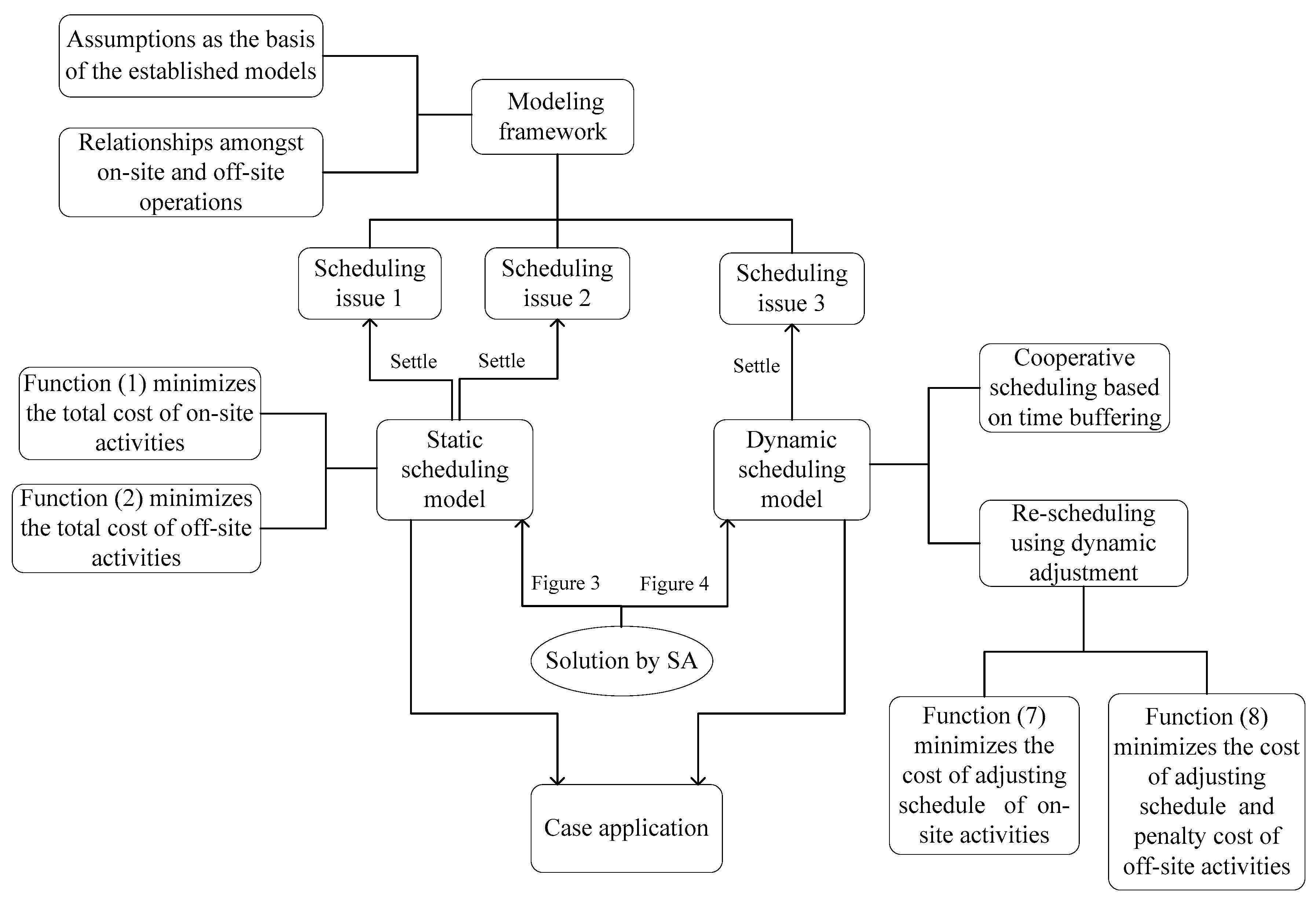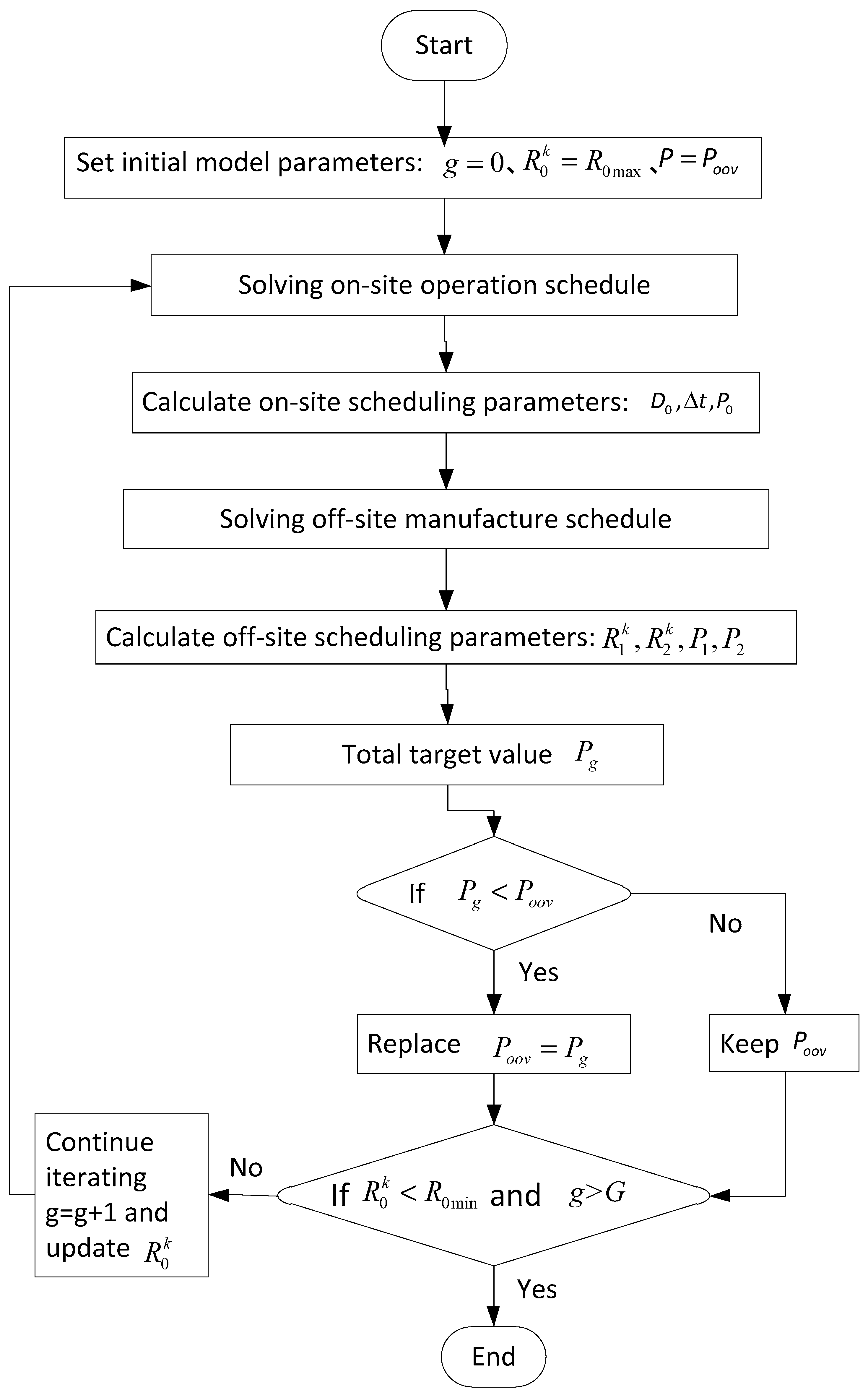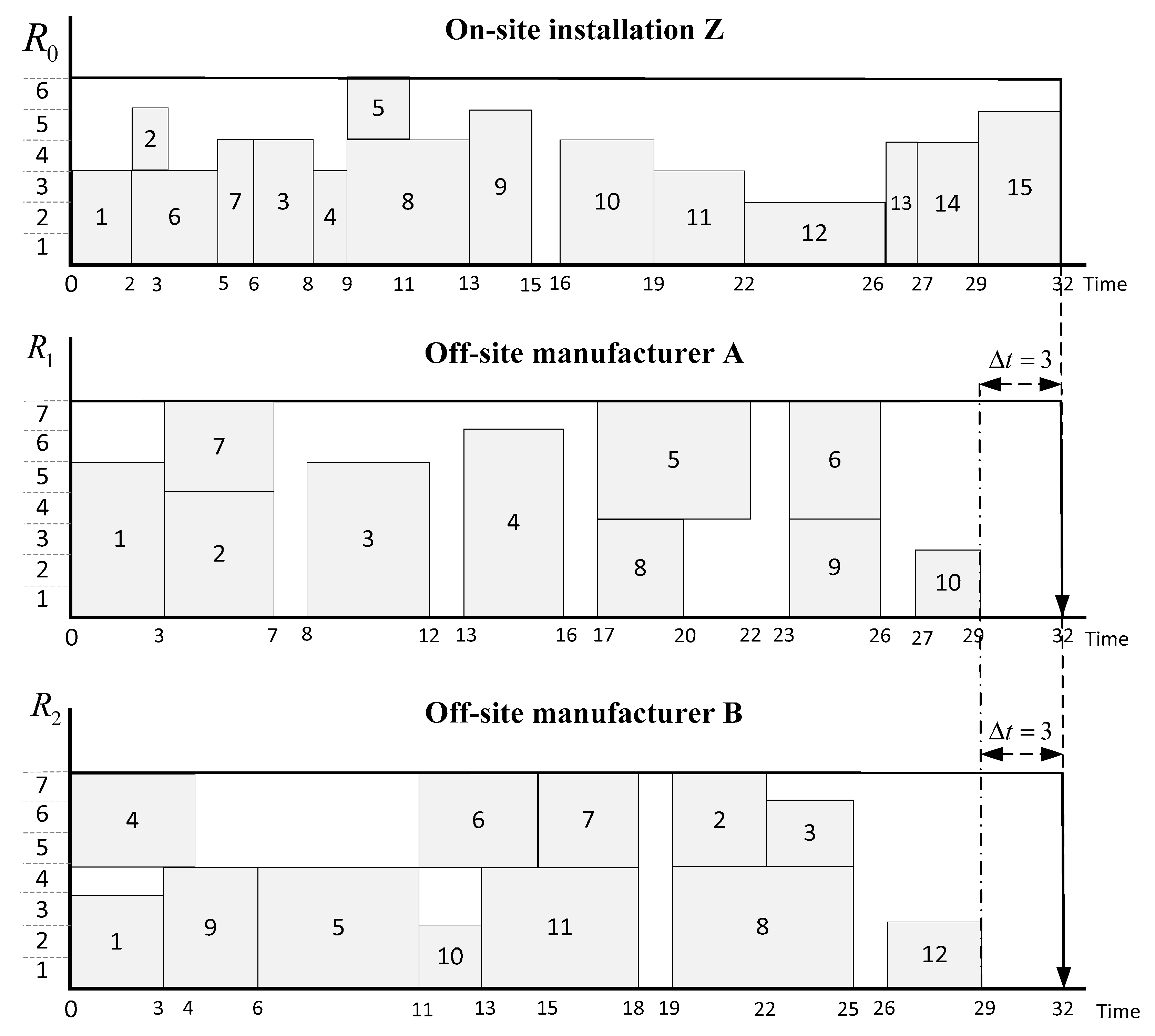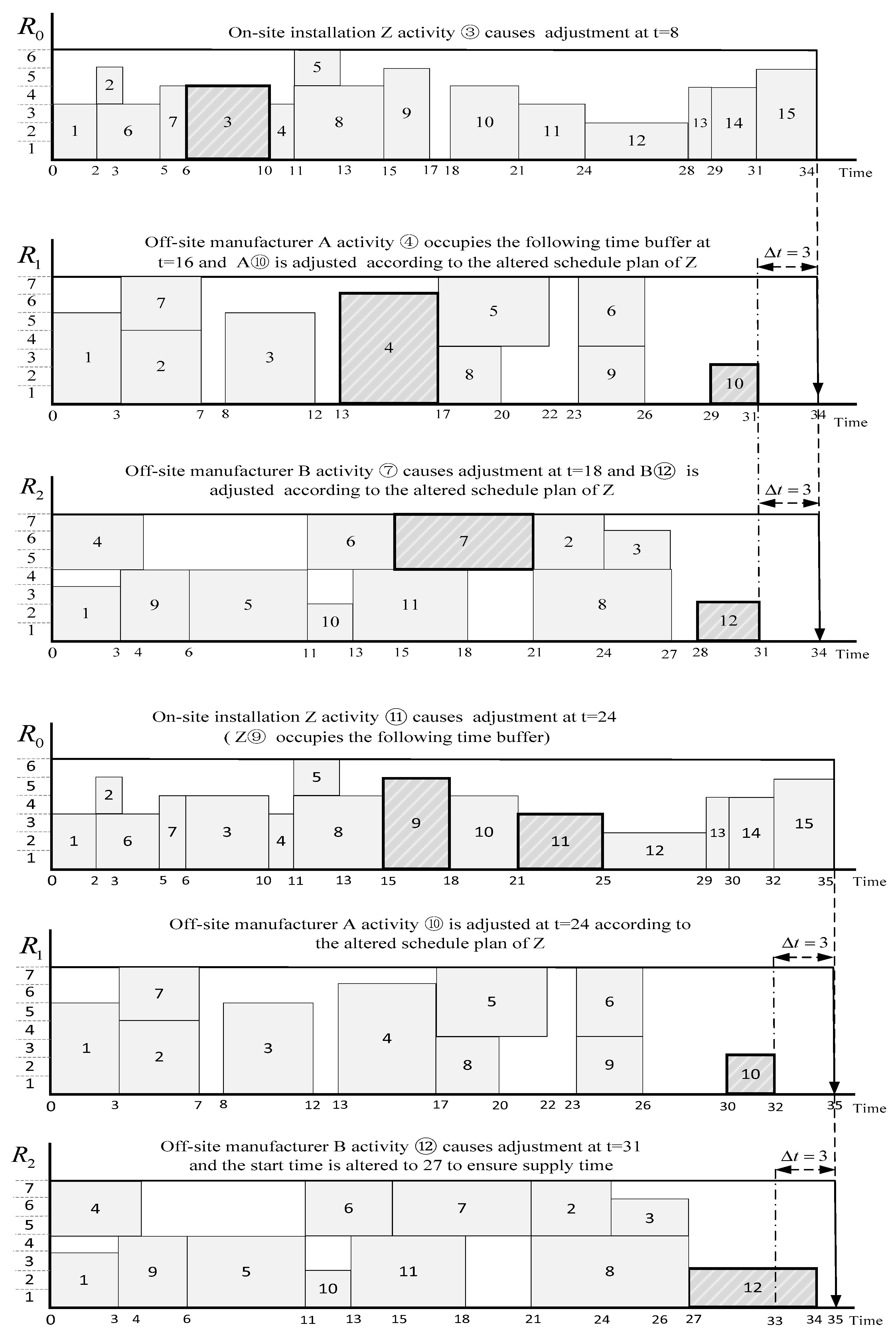Collaborative Scheduling of On-Site and Off-Site Operations in Prefabrication
Abstract
:1. Introduction
2. Literature Review
3. Methodology
3.1. Modeling Framework
- The resources used in operations are regarded as renewable. For instance, labor and equipment can be seized and released more than once by different activities. The overall amount of resources cannot exceed the maximum availability level (R).
- On-site and off-site operations are undertaken with respect to work flows and after completion of predecessors.
- The starting times of on-site installations are closely related to finishing times of manufacturing operations. To maintain the continuity of operations, on-site installations are initiated by off-site manufacture completions.
3.2. Scheduling Issues
- Real-time limitations in terms of resource availability, cost, and time along with both off-site manufacturing and on-site assembly processes.
- Large sizes of prefabricated panels and modules create spatial constraints for both off-site and on-site inventories.
4. Static Scheduling Model
4.1. Static Scheduling Model Development
4.2. Static Scheduling Model Solution
- Off-site and on-site construction processes are initially scheduled using the critical path method (with maximum resource availability, ). Resource quantities required by activities () are recorded.
- The following equation will enforce the limited quantity of available resources ():wherein g is the time of iteration, and G is the maximum number of iterations. The following two steps describe the calculation process in detail:
- ①
- Considering restrictions on and overall construction duration, the following variables are calculated: minimum , on-site installation duration , and the value of . For Cy1, the end time ; for Cy 2, the end time , and so on in the rest cycles.
- ②
- Based on above calculated values, and can be gained as the arrival time for prefabricated components. Considering the minimum of (i = 1, 2) as the optimal goal and the values of and , the initial optimal schedules of off-site manufacturing processes can be obtained.
- Based on the above calculations, the final target value p can be determined by Function (11). During the first iteration, the initial model parameters are set to g = 0, , and the calculation results from Function (11) are temporarily set as the overall optimal value (). After finishing the subsequent iteration, the new target value is compared with . If the new target value is optimal, it will replace the results in the last iteration and set a new . Simultaneously, the new combination scheduling plan will replace the last one correspondingly. Otherwise, will be kept, and the results in the recent iteration are discarded.
- The iterations end when and g > G. The most recent value of is set as the final overall optimal value p, and relative plans are accepted as the optimal schedules for on-site installation and off-site manufacturing plants (i = 1, 2), where SH is the starting time series indicated by .
5. Dynamic Scheduling Model Subject to Risk
5.1. Cooperative Scheduling Based on Time Buffering
- If bij ≥ ΔE, it indicates that the time buffer can eliminate the delay.
- If bij < ΔE, the delay of ΔE−bij will be transferred to the succeeding activities. If buffers of the following activities cannot eliminate the delay, the total duration of work has to be extended. The necessity of rescheduling is proposed to ensure that the cascading effect of the delay can be eliminated in the following cycles.
5.2. Rescheduling Using Dynamic Adjustment
- Delays related to on-site operations:
- Delays related to off-site operations:
5.3. Collaborative Scheduling Solution
6. Validation, Results, and Discussion
6.1. Calculation of Static Model
6.2. Calculation of Dynamic Model
- On-site installation Z
- Off-site manufacturer A
- Off-site manufacturer B
- On-site installation Z
- Off-site manufacturer A
- Off-site manufacturer B
6.3. Comparing with the Common Program
6.4. Discussion
- This study utilizes SA in work flow scheduling to obtain the optimized schedule plan referring to combinatorial targets for off-site construction.
- The established models firstly consider multiple suppliers related to one assembly site.
- The methodology analyzed in this study can effectively improve the schedule’s robustness in risky environments to support the sustainable development of prefabrication.
- However, the following limitations deserve to be further studied:
- The actual construction environment is more complicated, with, for instance, various risk events disrupting one activity or one risk event disrupting various activities, which is not under consideration in the case study.
- The more complicated workflows or other limited constraints can increase the difficulty of calculation and extend the calculation time, which is also the inherent defect of SA.
- This application is based on the assumption of exact assessment of risk events and related delay durations. Actually, the prediction of relevant parameters may not achieve the demanded accuracy using existing tools.
7. Conclusions
Author Contributions
Funding
Acknowledgments
Conflicts of Interest
Data Availability
References
- Boafo, F.E.; Kim, J.-H.; Kim, J.-T. Performance of Modular Prefabricated Architecture: Case Study-Based Review and Future Pathways. Sustainability 2016, 8, 558. [Google Scholar] [CrossRef] [Green Version]
- Arashpour, M.; Wakefield, R.; Blismas, N.; Maqsood, T. Autonomous production tracking for augmenting output in off-site construction. Autom. Constr. 2015, 53, 13–21. [Google Scholar] [CrossRef]
- Gong, P.; Teng, Y.; Li, X.; Luo, L. Modeling Constraints for the On-Site Assembly Process of Prefabrication Housing Production: A Social Network Analysis. Sustainability 2019, 11, 1387. [Google Scholar] [CrossRef] [Green Version]
- Jiang, W.; Luo, L.; Wu, Z.; Fei, J.; Antwi-Afari, M.F.; Yu, T. An Investigation of the Effectiveness of Prefabrication Incentive Policies in China. Sustainability 2019, 11, 5149. [Google Scholar] [CrossRef] [Green Version]
- Tomar, A.; Bansal, V.K. Scheduling of repetitive construction projects using geographic information systems: An integration of critical path method and line of balance. Asian J. Civ. Eng. 2019, 20, 549–562. [Google Scholar] [CrossRef]
- Hendradewa, A.P. Schedule Risk Analysis by Different Phases of Construction Project Using CPM-PERT and Monte-Carlo Simulation. In Proceedings of the 11th International Seminar on Industrial Engineering and Management: Technology and Innovation Challenges Towards Industry 4.0 Era, ISIEM, Makasar, South Sulawesi, Indonesia, 27–29 November 2018; Volume 528. [Google Scholar] [CrossRef] [Green Version]
- Wang, J.; Zeng, S.; Ju, J. Construction Schedule Management Using Resource-Constrained Project Scheduling Model. Tongji Daxue Xuebao 2017, 45, 1561–1568. (In Chinese) [Google Scholar]
- Lawrence, S.R.; Morton, T.E. Resource-constrained multi-project scheduling with tardy costs: Comparing myopic, bottleneck, and resource pricing heuristics. Eur. J. Oper. Res. 1993, 64, 168–187. [Google Scholar] [CrossRef]
- Tsubakitani, S.; Deckro, R.F. A heuristic for multi-project scheduling with limited resources in the housing industry. Eur. J. Oper. Res. 1990, 49, 80–91. [Google Scholar] [CrossRef]
- Mohanty, R.P.; Siddiq, M.K. Multiple projects-multiple resources-constrained scheduling: Some studies. Int. J. Prod. Res. 1989, 27, 261–280. [Google Scholar] [CrossRef]
- Ko, C.-H.; Wang, S.-F. GA-based decision support systems for precast production planning. Autom. Constr. 2010, 19, 907–916. [Google Scholar] [CrossRef]
- Ko, C.-H.; Wang, S.-F. Precast production scheduling using multi-objective genetic algorithms. Expert Syst. Appl. 2011, 38, 8293–8302. [Google Scholar] [CrossRef]
- Yang, Z.; Ma, Z.; Wu, S. Optimized flowshop scheduling of multiple production lines for precast production. Autom. Constr. 2016, 72, 321–329. [Google Scholar] [CrossRef] [Green Version]
- Arashpour, M.; Kamat, V.; Bai, Y.; Wakefield, R.; Abbasi, B. Optimization modeling of multi-skilled resources in prefabrication: Theorizing cost analysis of process integration in off-site construction. Autom. Constr. 2018, 95, 1–9. [Google Scholar] [CrossRef]
- Arashpour, M.; Wakefield, R.; Abbasi, B.; Arashpour, M.; Hosseini, M.R. Optimal process integration architectures in off-site construction: Theorizing the use of multi-skilled resources. Arch. Eng. Des. Manag. 2017, 14, 46–59. [Google Scholar] [CrossRef]
- Li, C.Z.; Xu, X.; Shen, G.Q.; Fan, C.; Li, X.; Hong, J. A model for simulating schedule risks in prefabrication housing production: A case study of six-day cycle assembly activities in Hong Kong. J. Clean. Prod. 2018, 185, 366–381. [Google Scholar] [CrossRef]
- Wang, J.; Li, W. Study on Factors Affecting Construction Schedule of Prefabricated Buildings Based on PCA. In Proceedings of the International Conference on Construction and Real Estate Management, Guangzhou, China, 10–12 November 2017. [Google Scholar] [CrossRef]
- Ji, Y.; Qi, L.; Liu, Y.; Liu, X.; Li, H.X. Assessing and Prioritising Delay Factors of Prefabricated Concrete Building Projects in China. Appl. Sci. 2018, 8, 2324. [Google Scholar] [CrossRef] [Green Version]
- Li, C.Z.; Zhong, R.Y.; Xue, F.; Xu, G.; Chen, K.; Huang, G.G.; Shen, G.Q. Integrating RFID and BIM technologies for mitigating risks and improving schedule performance of prefabricated house construction. J. Clean. Prod. 2017, 165, 1048–1062. [Google Scholar] [CrossRef]
- Kaplinski, O. Planning instruments in construction management. Technol. Econ. Dev. Econ. 2008, 14, 449–451. [Google Scholar] [CrossRef]
- Hola, B.; Schabowicz, K. Estimation of earthworks execution time cost by means of artificial neural networks. Autom. Constr. 2010, 19, 570–579. [Google Scholar] [CrossRef]
- Yang, J.B.; Taroun, D.L.A. Construction Risk Modeling and Assessment: Insights from a Literature Review. Built Hum. Environ. Rev. 2011, 4, 87–97. [Google Scholar]
- Van De Vonder, S.; Demeulemeester, E.; Herroelen, W.; Leus, R. The use of buffers in project management: The trade-off between stability and makespan. Int. J. Prod. Econ. 2005, 97, 227–240. [Google Scholar] [CrossRef] [Green Version]
- Jaskowski, P. Methodology for enhancing reliability of predictive project schedules in construction. Eksploatacja Niezawodn. Maint. Reliab. 2015, 17, 470–479. [Google Scholar] [CrossRef]
- Mehta, S.V.; Uzsoy, R.M. Predictable scheduling of a job shop subject to breakdowns. IEEE Trans. Robot. Autom. 1998, 14, 365–378. [Google Scholar] [CrossRef]
- Herroelen, W.; Leus, R. The construction of stable project baseline schedules. Eur. J. Oper. Res. 2004, 156, 550–565. [Google Scholar] [CrossRef]
- Schatteman, D.; Herroelen, W.; Van De Vonder, S.; Boone, A. Methodology for Integrated Risk Management and Proactive Scheduling of Construction Projects. J. Constr. Eng. Manag. 2008, 134, 885–893. [Google Scholar] [CrossRef]
- Duque-Antón, M. Constructing efficient simulated annealing algorithms. Discret. Appl. Math. 1997, 80, 115. [Google Scholar] [CrossRef] [Green Version]
- Payá, I.; Yepes, V.; González-Vidosa, F.; Hospitaler, A. Multiobjective Optimization of Concrete Frames by Simulated Annealing. Comput. Civ. Infrastruct. Eng. 2008, 23, 596–610. [Google Scholar] [CrossRef]
- Yeh, I.-C. Construction-Site Layout Using Annealed Neural Network. J. Comput. Civ. Eng. 1995, 9, 201–208. [Google Scholar] [CrossRef]
- Wu, K.; De Soto, B.G.; Zhang, F. Spatio-temporal planning for tower cranes in construction projects with simulated annealing. Autom. Constr. 2020, 111, 103060. [Google Scholar] [CrossRef]
- Ryu, D.-W.; Kim, J.I.; Suh, S.; Suh, W. Evaluating risks using simulated annealing and Building Information Modeling. Appl. Math. Model. 2015, 39, 5925–5935. [Google Scholar] [CrossRef]
- Leung, T.; Chan, C.K.; Troutt, M.D. Application of a mixed simulated annealing-genetic algorithm heuristic for the two-dimensional orthogonal packing problem. Eur. J. Oper. Res. 2003, 145, 530–542. [Google Scholar] [CrossRef]
- Suliman, M.O.; Kumar, V.S.; Abdulal, W. Optimization of uncertain construction time-cost trade off problem using simulated annealing algorithm. In Proceedings of the 2011 World Congress on Information and Communication Technologies, Mumbai, India, 11–14 December 2011; pp. 489–494. [Google Scholar]
- Nasirian, A.; Arashpour, M.; Abbasi, B. Critical Literature Review of Labor Multiskilling in Construction. J. Constr. Eng. Manag. 2019, 145, 04018113. [Google Scholar] [CrossRef]
- Hosseini, M.R.; Martek, I.; Chileshe, N.; Zavadskas, E.K.; Arashpour, M. Assessing the Influence of Virtuality on the Effectiveness of Engineering Project Networks: “Big Five Theory” Perspective. J. Constr. Eng. Manag. 2018, 144, 04018059. [Google Scholar] [CrossRef]
- Hoel, K.; Taylor, S.G. Quantifying buffers for project schedules. Prod. Inventory Manag. J. 1999, 40, 43–47. [Google Scholar]
- He, Z.W.; Liu, R.J.; Yu, X.U. Robust scheduling optimization for resource-constrained project based on random duration of activities. Syst. Eng. Theory Pract. 2013, 33, 650–659. [Google Scholar]
- Lambrechts, O.; Demeulemeester, E.; Herroelen, W. A tabu search procedure for developing robust predictive project schedules. Int. J. Prod. Econ. 2008, 111, 493–508. [Google Scholar] [CrossRef]









| Indices | Specification |
|---|---|
| i | Construction zones; i = 0 indicates on-site installation, i = 1, 2 indicates manufacturing |
| j | Working activities; , where J is the last activity in an operation |
| t | Time; , where is the total duration of the whole project |
| Duration of the time window (TW) | |
| Ration factor of TW, | |
| w | Cost of TW management per day |
| The earliest manufacturing time in cycle n (Cyn) | |
| The latest manufacturing time in Cyn | |
| The parameter of storage cost per day, > 0 | |
| The parameter of penalty cost per day, > 0 | |
| Resources; , where K is the total number of the renewable resource types | |
| The duration of activity j in construction zone i | |
| The starting date of activity j in construction zone i | |
| The finishing date of activity j in construction zone i, | |
| The set of preceding activities of j in construction zone i | |
| The set of succeeding activities of j in construction zone i | |
| The set of activities in progress on day t in construction zone i | |
| All the activities included in construction zone i | |
| The available quantity of resource k in construction zone i | |
| Maximum availability of resource k, where The quantity of resource k required by activity j in construction zone i | |
| Cost of single unit k per day in construction zone i | |
| Total cost in construction zone i | |
| Duration of the operation in zone i | |
| D | Total duration of the whole project |
| Activity | Name | Preceding Activity | |||
|---|---|---|---|---|---|
| ST | Start | 0 | 0 | - | 0 |
| 1 | Component approach | 2 | 3 | ST | 3 |
| 2 | Measurement and setting out | 1 | 2 | ST | 3 |
| 3 | Prefabricated wall hoisting | 2 | 4 | 1, 2 | 9 |
| 4 | Installation of wall with oblique support | 1 | 3 | 3 | 4 |
| 5 | Plug joint, sleeve grouting, and cast-in-place walls and columns | 2 | 2 | 4 | 4 |
| 6 | Rebar colligation and formwork | 3 | 3 | 1 | 4 |
| 7 | Post-cast strip formwork | 1 | 4 | 6 | 4 |
| 8 | Rebar colligation and formwork of cast-in-place beams | 4 | 4 | 7 | 5 |
| 9 | Prefabricated superposed beam lifting | 2 | 5 | 5, 8 | 8 |
| 10 | Prefabricated superposed slab lifting | 3 | 4 | 9 | 6 |
| 11 | Prefabricated heteromorphic component lifting | 3 | 3 | 2, 10 | 7 |
| 12 | Colligation of rebar below slab in cast-in-place zone | 4 | 2 | 11 | 5 |
| 13 | Embedded pipeline installation | 1 | 4 | 12 | 5 |
| 14 | Colligation of rebar above beam and slab | 2 | 4 | 13 | 6 |
| 15 | Structural concrete pouring | 3 | 5 | 14 | 8 |
| SF | End | 0 | 0 | 15 | 200 |
| Number | Component | Type | Quantity | |
|---|---|---|---|---|
| 1 | YWQ | 6 | 43 | 71.92 |
| 2 | YNQ | 3 | 19 | 12.73 |
| 3 | YDL | 3 | 31 | 34.72 |
| 4 | YDB | 5 | 80 | 5.93 |
| 5 | YYB | 1 | 8 | 7.41 |
| 6 | YKB | 1 | 5 | 1.47 |
| Activity Number | Activity Name | Preceding Activity | ||||
|---|---|---|---|---|---|---|
| Off-site manufacturer A | ST | Start | 0 | 0 | - | 0 |
| 1 | YWQ1 | 3 | 5 | ST | 4 | |
| 2 | YWQ2 | 4 | 4 | 1 | 5 | |
| 3 | YWQ3 | 4 | 5 | 2 | 7 | |
| 4 | YWQ4 | 3 | 6 | 3 | 7 | |
| 5 | YWQ5 | 5 | 4 | 4 | 5 | |
| 6 | YWQ6 | 3 | 4 | 5 | 6 | |
| 7 | YNQ1 | 4 | 3 | ST | 4 | |
| 8 | YNQ2 | 3 | 3 | 7 | 4 | |
| 9 | YNQ3 | 3 | 3 | 8 | 4 | |
| 10 | YS | 2 | 2 | 5, 9 | 10 | |
| SF | End | 0 | 0 | 10 | 7 | |
| Off-site manufacturer B | ST | Start | 0 | 0 | - | 0 |
| 1 | YDL1 | 3 | 3 | ST | 4 | |
| 2 | YDL2 | 3 | 3 | 1 | 4 | |
| 3 | YDL3 | 3 | 2 | 2 | 4 | |
| 4 | YDB1 | 4 | 3 | ST | 6 | |
| 5 | YDB2 | 5 | 4 | 4 | 7 | |
| 6 | YDB3 | 4 | 3 | 5 | 8 | |
| 7 | YDB4 | 3 | 3 | 6 | 8 | |
| 8 | YDB5 | 6 | 4 | 7 | 7 | |
| 9 | YYB | 3 | 4 | ST | 5 | |
| 10 | YKB | 2 | 2 | 9 | 7 | |
| 11 | YLT | 5 | 4 | 10 | 8 | |
| 12 | YS | 3 | 2 | 3, 8, 11 | 9 | |
| SF | End | 0 | 0 | 12 | 6 |
| Activity Group | Total Float | ||||
|---|---|---|---|---|---|
| On-site installation Z | 1 | ||||
| Off-site manufacturer A | 8 | ||||
| 5 | |||||
| Off-site manufacturer B | 5 | ||||
| 2 |
Publisher’s Note: MDPI stays neutral with regard to jurisdictional claims in published maps and institutional affiliations. |
© 2020 by the authors. Licensee MDPI, Basel, Switzerland. This article is an open access article distributed under the terms and conditions of the Creative Commons Attribution (CC BY) license (http://creativecommons.org/licenses/by/4.0/).
Share and Cite
Chen, W.; Zhao, Y.; Yu, Y.; Chen, K.; Arashpour, M. Collaborative Scheduling of On-Site and Off-Site Operations in Prefabrication. Sustainability 2020, 12, 9266. https://doi.org/10.3390/su12219266
Chen W, Zhao Y, Yu Y, Chen K, Arashpour M. Collaborative Scheduling of On-Site and Off-Site Operations in Prefabrication. Sustainability. 2020; 12(21):9266. https://doi.org/10.3390/su12219266
Chicago/Turabian StyleChen, Wei, Ying Zhao, Yangqing Yu, Kaiman Chen, and Mehrdad Arashpour. 2020. "Collaborative Scheduling of On-Site and Off-Site Operations in Prefabrication" Sustainability 12, no. 21: 9266. https://doi.org/10.3390/su12219266





